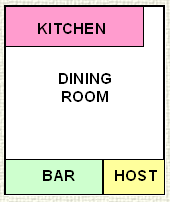1. SALES CONTROL
2. INVENTORY CONTROL
3. LABOR CONTROL
4. OPERATING EXPENSE CONTROL
Revenues and expenses are controllable if they are influenced by management. Inventory and Labor are the largest controllable expenses. Direct Operating Expenses, Utilities, Marketing, and R&M, are usually controllable. Occupancy costs and Non-operating expenses, such as interest, are usually not controllable.
Cost Of Goods Sold
Labor Cost
Operating Expense
Non-Operating Expense
to Prime Cost (COGS + Labor)27-32¢ goes to operating costs.
Revenue, inventory, and labor control systems can be broken down by separate departments in the restaurant, such as kitchen, bar, service, and front desk. These departments usually have their own inventory, schedules, and operating standards.
Once standards have been developed, realistic expectations can be calculated for inventory and labor costs, based on the actual daily sales mix for each department. Control is used to measure the performance of each department manager and the general manager.

We use a systematic approach to developing and implementing control systems for restaurants called the Bullseye Profit Process.
